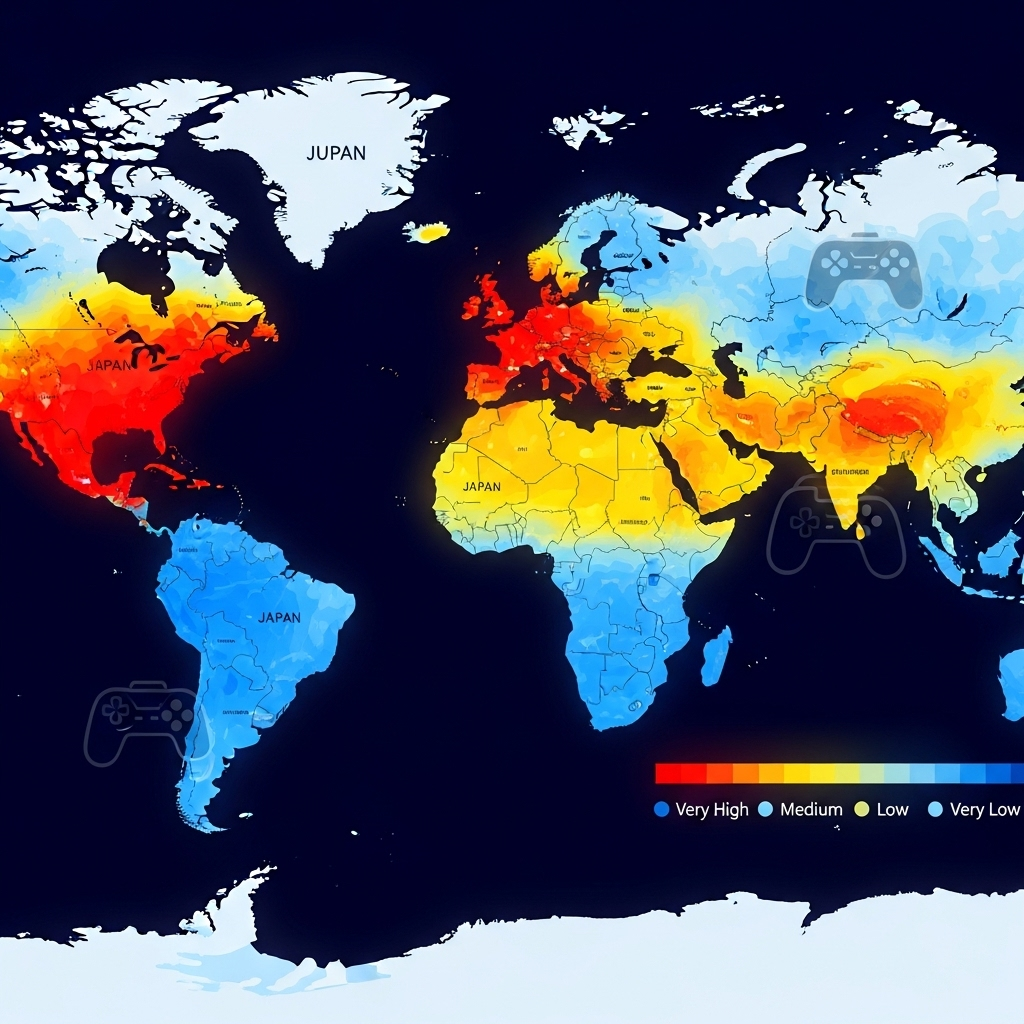The eternal battle between PlayStation and Xbox has entered a new phase in 2025, with Sony’s PlayStation 5 maintaining a commanding 5:1 sales advantage while Microsoft pivots toward a platform-agnostic future. This generation’s console war has evolved beyond hardware specifications to encompass service models, exclusive content strategies, and fundamental visions for gaming’s future.
Sales Performance and Market Dynamics
PlayStation 5’s dominance in unit sales tells only part of the story. With over 65 million units sold compared to Xbox Series X/S’s 28 million, Sony has maintained its traditional hardware advantage. However, these numbers obscure Microsoft’s strategic shift away from hardware-centric metrics toward service-based success measurements.
The regional variations in console preference remain stark. PlayStation maintains an almost monopolistic position in Japan with 96% market share, while Xbox has gained ground in North America, achieving 42% market share. Europe remains PlayStation territory at 74% share, while emerging markets show more price sensitivity, favoring the cheaper Xbox Series S.
Supply chain management has played a crucial role in this generation’s dynamics. Sony’s aggressive semiconductor securing and manufacturing partnerships ensured better availability during the crucial launch period. Microsoft’s dual-SKU strategy with Series S and X created production complexities that limited Series X availability while Series S units accumulated in inventory.
Technical Capabilities and Real-World Performance
The paper specifications suggested Xbox Series X would be the performance leader with 12 teraflops versus PlayStation 5’s 10.28. However, real-world performance has proven more nuanced. PlayStation 5’s custom SSD architecture with 5.5 GB/s raw throughput has enabled exclusive experiences impossible on any other platform, including Xbox’s still-impressive 2.4 GB/s SSD.
The PlayStation 5’s Tempest 3D AudioTech has delivered on promises of immersive spatial audio without additional hardware. Xbox’s implementation of Dolby Atmos provides excellent audio but requires compatible sound systems for full benefit. This difference exemplifies Sony’s integrated approach versus Microsoft’s partnership strategy.
Both consoles have delivered on ray tracing promises, though implementation varies by developer commitment rather than hardware limitations. The Xbox Series X’s additional compute power shows advantages in games optimized for it, achieving higher resolutions or frame rates. However, PlayStation’s larger install base means most third-party titles optimize for PS5 first.
Exclusive Content Strategies
Sony’s first-party studio dominance continues with critically acclaimed titles that define the generation. Spider-Man 2, God of War Ragnarök, and Horizon Forbidden West showcase PlayStation’s commitment to prestige single-player experiences. These tent-pole releases drive hardware sales and subscription sign-ups while reinforcing PlayStation’s premium brand positioning.
Microsoft’s acquisition strategy, including the $69 billion Activision Blizzard purchase, represents a longer-term play for content dominance. While immediate exclusive benefits remain limited due to regulatory commitments, Microsoft’s portfolio of studios now exceeds Sony’s in both number and IP value. The challenge lies in coordinating these studios to produce consistent, quality output.
The timed exclusive strategy has evolved with both platforms securing limited-time advantages rather than permanent exclusivity for third-party titles. This approach reduces costs while still providing differentiation. However, player awareness of eventual multi-platform releases has reduced timed exclusives’ hardware-selling impact.
Service Models and Subscription Strategies
Xbox Game Pass has fundamentally changed the conversation around gaming value propositions. With over 33 million subscribers accessing hundreds of games including day-one releases, Game Pass has forced Sony to respond with PlayStation Plus Premium. However, Sony’s reluctance to include first-party titles at launch maintains a fundamental philosophical difference.
The economics of subscription services reveal divergent strategies. Microsoft accepts short-term losses on Game Pass, betting on long-term subscriber growth and engagement. Sony maintains profitability focus, offering older titles and limiting day-one releases to preserve traditional game sales. This difference reflects Microsoft’s platform company DNA versus Sony’s entertainment company heritage.
Cloud gaming integration shows Microsoft’s infrastructure advantage through Azure. Xbox Cloud Gaming provides seamless experiences across devices, while PlayStation’s streaming remains secondary to downloaded games. This capability difference might prove decisive as 5G proliferates and cloud gaming matures.
Backward Compatibility and Preservation
Microsoft’s comprehensive backward compatibility program supports thousands of titles across four generations. Smart Delivery ensures players always access optimal game versions without confusion. This consumer-friendly approach has earned significant goodwill, particularly among long-time Xbox fans with extensive digital libraries.
PlayStation’s backward compatibility remains limited to PS4 titles, with older games available only through streaming or remasters. While this limitation hasn’t significantly impacted sales, it represents missed opportunities for leveraging PlayStation’s extensive legacy catalog. Sony’s focus on remasters and remakes monetizes nostalgia but at additional cost to consumers.
Digital preservation concerns grow as online services become integral to game functionality. Both platforms face criticism for games becoming unplayable when servers shut down. Microsoft’s commitment to backward compatibility suggests longer-term preservation thinking, while Sony’s generation-focused approach raises questions about long-term game accessibility.
Innovation and Future Technologies
The PlayStation VR2 represents Sony’s continued commitment to virtual reality as gaming’s future. With advanced features like eye tracking and haptic feedback, PSVR2 provides experiences unavailable elsewhere. However, limited software support and high price point have restricted adoption to enthusiasts.
Microsoft’s decision to skip VR this generation appears prescient given market realities. Instead, Xbox focuses on cloud streaming, mobile integration, and service expansion. This pragmatic approach avoids risky hardware investments while positioning Xbox for platform-agnostic futures.
Both consoles have embraced environmental sustainability with carbon neutral commitments and energy efficiency improvements. The PS5’s variable frequency approach optimizes power consumption, while Xbox’s efficiency mode reduces standby power. These initiatives respond to environmental concerns while potentially reducing operational costs.
Developer Relations and Platform Policies
Sony’s developer-friendly reputation continues attracting exclusive partnerships and optimized third-party titles. The PlayStation architecture’s consistency across generations simplifies development, while robust development tools enable technical achievements showcased in exclusive titles.
Microsoft’s more open approach includes extensive documentation, better indie support through ID@Xbox, and cross-platform development tools. The company’s embrace of PC gaming through simultaneous releases eliminates traditional console exclusivity but expands addressable markets.
Platform policies around cross-play and user-generated content show philosophical differences. Microsoft’s early embrace of cross-play forced Sony to follow, though implementation remains inconsistent. Content moderation approaches differ, with Sony taking more restrictive stances that sometimes frustrate developers and players.
Market Expansion Strategies
Geographic expansion efforts reveal different priorities. Sony focuses on maintaining dominance in established markets while slowly expanding in growth regions. Microsoft aggressively pursues emerging markets with Xbox All Access payment plans and cloud gaming that eliminates hardware barriers.
Mobile gaming integration strategies diverge significantly. Microsoft’s cloud gaming push brings Xbox games to billions of mobile devices. Sony’s mobile efforts remain limited despite acquiring mobile developer Savage Game Studios. This difference might prove crucial as mobile gaming continues dominating global gaming revenue.
The PC platform approach starkly differentiates the companies. Microsoft’s day-one PC releases through Steam and Windows Store maximize reach but potentially cannibalize console sales. Sony’s delayed PC ports preserve console exclusivity while generating additional revenue from double-dippers.
Financial Performance and Business Models
Revenue analysis reveals different success metrics. PlayStation generates higher gaming revenue through hardware sales and first-party software. Xbox shows faster growth in services revenue through Game Pass and cloud initiatives. These divergent models make direct comparison increasingly difficult.
Profit margins tell complex stories about strategy effectiveness. PlayStation maintains higher margins through premium pricing and exclusive content. Xbox accepts lower margins while building subscriber base and ecosystem lock-in. Long-term profitability depends on whether subscription models can maintain growth while improving margins.
Investment priorities reflect fundamental strategic differences. Sony invests in content creation and hardware innovation. Microsoft invests in infrastructure, acquisitions, and service development. These choices will determine success as gaming evolves beyond traditional console generations.
The Future Beyond Traditional Console Wars
The traditional console war narrative becomes increasingly obsolete as platforms pursue divergent strategies. Sony doubles down on premium experiences and hardware differentiation. Microsoft builds platform-agnostic services accessible everywhere. Both strategies can succeed in an expanding gaming market.
Regulatory scrutiny of consolidation might prevent further major acquisitions, forcing organic growth and innovation. This could benefit consumers through increased competition and creative risk-taking. However, the subscription service arms race might lead to market fragmentation reminiscent of video streaming.
The next generation of consoles, expected around 2028, might be the last traditional generation. Cloud gaming, service models, and mobile integration suggest futures where hardware becomes secondary to ecosystems. The winners will be platforms that successfully navigate this transition while maintaining player engagement and developer support. The console wars of 2025 represent not just competition between two boxes but fundamentally different visions for interactive entertainment’s future.





